President Joe Biden will be designating a portion of land in the Grand Canyon region as a national monument and limiting mining in the area—a move criticized as jeopardizing America’s uranium fuel security.
On Tuesday, Mr. Biden is expected to sign a proclamation establishing the Baaj Nwaavjo I’tah Kukveni—Ancestral Footprints of the Grand Canyon National Monument in Arizona. This will be the fifth national monument established by Mr. Biden. The monument “will conserve nearly 1 million acres of public lands surrounding Grand Canyon National Park. The new monument protects thousands of cultural and sacred sites that are precious to Tribal Nations in the Southwest,” an Aug. 8 White House fact sheet says.





